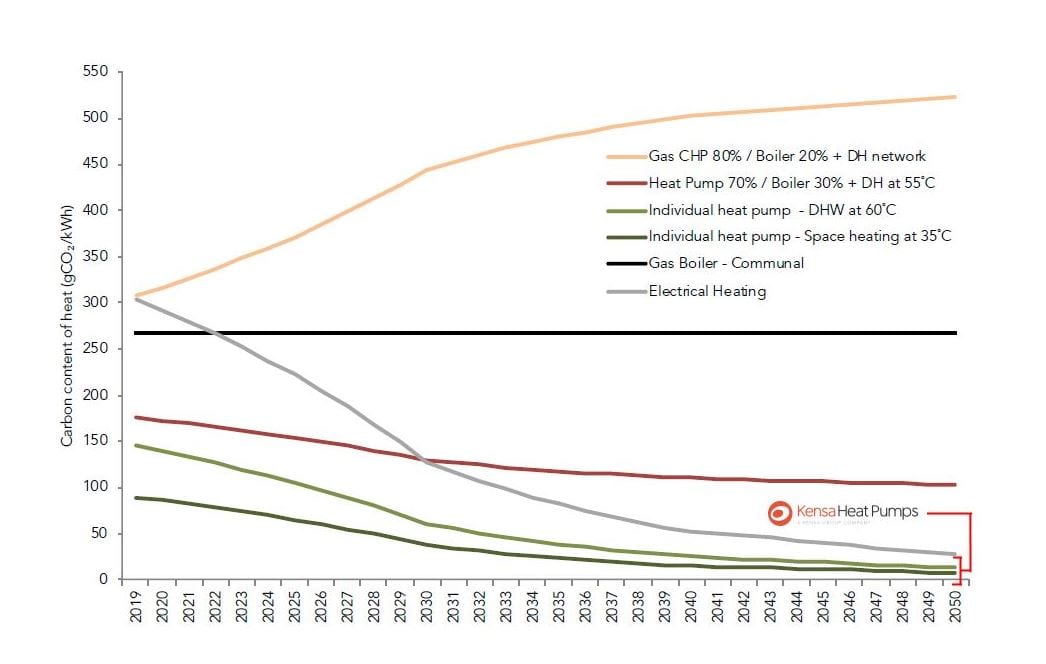The pressure to deliver low carbon, low polluting new build homes today has significant impacts on health and the environment now and in the future.
The combination of the carbon and running cost savings of ground source heat pumps with shared ground loop arrays make them the most efficient and lowest cost solution for new build homes, compared to various air source, direct electric and gas alternatives.
These advantages also make ground source heat pumps the easiest and cheapest means to cost effectively deliver carbon compliant homes.
Carbon Content of Heat

Projected carbon factor of heat based on HM Treasury Green Book marginal emission factors.
Building regulations require CO2 emissions of a new development, the ‘Dwelling Emission Rate’ (DER), to be below the ‘Target Emission Rate’ (TER), the emissions of a notional building of the same size and shape as the development; the target rate is set within the current Standard Assessment Procedure (SAP) in Part L of the Building Regulations.
As non-combustion systems, ground source heat pumps emit no point of use CO2 emissions, nor any pollution for that matter.
Building regulations and SAP take into account the carbon intensity and emissions of what is powering the heating system, in ground source heat pumps case, electricity.
Read more
As a highly efficient form of heating – delivering 3-4kW of heat for every 1kW of electrical energy used to power the pump – ground source heat pumps offer an ultra-low carbon solution.
Just how ‘low-carbon’ a shared ground loop ground source heat pump system is compared to other heating alternatives is dependent on the carbon factors assumed for each energy source.
SAP2012 & SAP10 Comparisons
Currently carbon factors used in Part L are based on those in SAP2012.
Using the current electricity related carbon emissions in SAP2012 for electricity at 519gCO2/kWh, Kensa’s shared ground loop array ground source heat pump system operating at 320% efficiency produces a carbon saving of 36.9% compared to a gas combi boiler.
The proposed next version of SAP (SAP 10) – and already adopted by London – reduces the figure of electricity related carbon emissions to 233gCO2/kWh, similar to those of gas, due to the increasing decarbonisation of the electricity grid with clean, renewable energy sources such as wind and solar PV replacing the burning of coal.
Thanks to ground source heat pumps efficiencies, by more than halving the CO2 emission factors for electricity in SAP10 the carbon saving for ground source compared to a gas combi boiler would be 70.9%.
SAP10 Comparison of Part L Improvements

SAP10 comparison of Part L improvement results (assuming a carbon factor of 233gCO2 /kWh for electricity).
Careful consideration of how a development is to be heated could save developments several tonnes of CO2 and also tons of money in offset funds, too.
To achieve London’s zero carbon commitments by 2050, all new developments in London must achieve an on-site carbon reduction of at least 35% beyond the Target Emission Rate (TER). This percentage will increase over time in order to achieve the zero-carbon London ambition and reflect the cost of more efficient construction methods.
The new Draft London Plan goes a step further, stating 10% of the 35% target should be met through energy efficiency measures alone, encouraging a sensible fabric first approach.
As further impetus for ultra-efficient builds, any residual CO2 emissions are to be offset and paid for by the developer at a suggested rate of £95/tonne, which is utilised by carbon offset funds for further energy efficiency improvements in London boroughs.
Read more
The impact of changing carbon factors means the cost to comply with emissions reduction targets increases for developers who traditionally specified gas, in particular gas CHP, whilst it becomes cheaper for those specifying heat pumps.
For developers in London using SAP10 figures and the Draft London Plan’s proposed minimum 10% fabric efficiency measures, the simplest and cheapest way to achieve carbon compliance is to specify a ground source heat pump alongside the minimum energy efficiency measure requirements. By simply coupling the 10% energy efficiency measure improvements with a ground source heat pump, a development’s emissions would be reduced by 74%, leaving just 26% to be offset.
For a best practice scenario, developments featuring 10% fabric efficiencies plus 25% additional energy efficiency measures such as solar PV and heat recovery ventilation alongside a ground source heat pump, would result in a carbon offset price of £871. Compare this to a gas combi boiler where the carbon offset price would be £2,992, equating to a saving of £636,300 on a 300 unit development.
Related Content
Summary: Cost to comply with emissions reduction targets to increase for developers who traditionally specified gas, in particular gas CHP, and decrease for those specifying shared ground loop array ground source heat pumps. GLA heat pumps report identifies shared ground loop arrays with individual ground source heat pumps as the lowest carbon & lowest cost…



